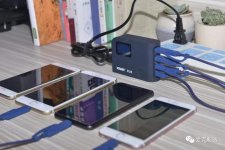Several days ago, a friend told me that "The e-cigarette I bought has two built-in unprotected 18650 batteries. The merchant said that they can charge directly without removing the battery. But I don't know if it will be dangerous to charge directly. How do I charge it properly?" Nowadays, many electronic cigarettes, flashlights and camera stabilizers on the market have built-in lithium batteries for power supply, and also provide direct charge. Today I'd like to talk about the charging methods.
Charging Method 1: Direct Charging
What is direct charge? Direct charging is our usual cable charging. The charging output port is directly connected to the charged device such as electronic cigarette, gimbal, camera, and mobile phone through a data cable, and then the battery is charged through the built-in host. In this charging method, the charging cable is usually equipped with an adapter, and its role is to convert AC power to DC power.

Advantage:
It can be charged without disassembling the battery. One the one hand, it is convenient in use. On the other hand, it can ensure the tightness of the device to the greatest extent.
Disadvantages:
The devices like flashlights and vape mods need to be fully charged before it can be used, so When you need them urgently, replacing the battery is faster and easier than charging them directly. In addition, it has an impact on charging safety and battery life.
Let's explain it in detail.
This direct charging method is only an additional function of most devices on the market, and its precision is far from enough. In addition, the charging current is fixed during the charging process, and the current cannot be adjusted according to the actual situation of the battery. Long-term direct charging will greatly shorten the life of the rechargeable battery.
Due to the portability of the device, the charging current is generally small. In this case, the charging will take a long time. The charging of common electronic cigarettes and other devices takes about 4 hours or more. If these devices run out of power during use, and the direct charge type cannot be immediately powered on, this will cause a lot of inconvenience.
If the battery is left unused in the device for a long time, it is prone to over-discharge, and because the power control system of the device does not have reviving function, it will appear that the direct-charge battery cannot be charged. Some people will mistakenly think that the battery is broken and throw it away, causing unnecessary waste and loss.
Two or more lithium batteries, whether in parallel or in series or in series and parallel together, must first be paired to ensure that their performance are the same or very close, and the issue of balanced charging must be considered when charging.
In reality, the cost of balanced charging is high, the size of the device needs to be increased, and the efficiency is not high, which is likely to be sacrificed by bad manufacturers. If there is no balanced charging with reliable performance, in parallel or in series, some batteries will always bear the main load or be charged first. As a result, some batteries will soon wear out first, and the performance of the entire battery group will be insufficient. Severe cases lead to accidents.
Tips:
1. During the direct charging process, if there is a crack in the outer shell of the data cable, the metal wire is exposed, or the entire wire is aging, etc., please replace it with a new one in time.
2. When the device is not used for a long time, remember to charge it to 60% storage every 3 months.
3. When choosing direct charge, you should try to ensure that it is fully charged and cut off the power or choose a device with overcharge protection function (such as device equipped with XTAR ESS technology).
4. For direct charging of two batteries or more, it is best to use the direct charging as an emergency. Try to desktop charge the battery as much as possible. After at least 3-5 times of direct charging, take it out for desktop charging, to know and guarantee the balance of the battery pack.
Charging Method 2: Desktop Charging
Desktop Charging means remove the battery in the device into a specific battery charger and charge it with external battery charger.
The desktop charger is similar to the direct charging in charging principle, except that it becomes a direct charging of the charger.

Advantage:
You can charge the two or more batteries alternately without affecting the use of the device. At the same time, it can also charge the same type of battery for other purposes.
Professional chargers generally have a smart charging mode, which automatically adjusts the charging method according to the current state of the battery. Like XTAR ST2, it is upgraded to Type-C input. Besides, it has 4.1A fast charging, and temperature control safety protection and other functions. The devices and most chargers on the market do not have these functions.
From a performance point of view, a desktop charger can well solve the problem of balanced charging by charging each slot independently, and it can make more value-added performance, such as 0V activation function of XTAR, capacity test, internal resistance test.
Disadvantages:
When charging, you need to remove the battery from the device, it is not so convenient. Frequent disassembly will make the interface of the device becomes slack.
The Right Charging Method
Now we know that direct charging will be more convenient than desktop charging, but the safety of the desktop charging will be better. So, I suggest that: Any device that can remove batteries and has no professional safe-charging protection functions, such as electronic cigarettes, it is best to remove the lithium battery from the device and use a professional charger for charging.
What's your charging method? And what's your suggestion? Don't hesitate to comment below.
Charging Method 1: Direct Charging
What is direct charge? Direct charging is our usual cable charging. The charging output port is directly connected to the charged device such as electronic cigarette, gimbal, camera, and mobile phone through a data cable, and then the battery is charged through the built-in host. In this charging method, the charging cable is usually equipped with an adapter, and its role is to convert AC power to DC power.

Advantage:
It can be charged without disassembling the battery. One the one hand, it is convenient in use. On the other hand, it can ensure the tightness of the device to the greatest extent.
Disadvantages:
The devices like flashlights and vape mods need to be fully charged before it can be used, so When you need them urgently, replacing the battery is faster and easier than charging them directly. In addition, it has an impact on charging safety and battery life.
Let's explain it in detail.
This direct charging method is only an additional function of most devices on the market, and its precision is far from enough. In addition, the charging current is fixed during the charging process, and the current cannot be adjusted according to the actual situation of the battery. Long-term direct charging will greatly shorten the life of the rechargeable battery.
Due to the portability of the device, the charging current is generally small. In this case, the charging will take a long time. The charging of common electronic cigarettes and other devices takes about 4 hours or more. If these devices run out of power during use, and the direct charge type cannot be immediately powered on, this will cause a lot of inconvenience.
If the battery is left unused in the device for a long time, it is prone to over-discharge, and because the power control system of the device does not have reviving function, it will appear that the direct-charge battery cannot be charged. Some people will mistakenly think that the battery is broken and throw it away, causing unnecessary waste and loss.
Two or more lithium batteries, whether in parallel or in series or in series and parallel together, must first be paired to ensure that their performance are the same or very close, and the issue of balanced charging must be considered when charging.
In reality, the cost of balanced charging is high, the size of the device needs to be increased, and the efficiency is not high, which is likely to be sacrificed by bad manufacturers. If there is no balanced charging with reliable performance, in parallel or in series, some batteries will always bear the main load or be charged first. As a result, some batteries will soon wear out first, and the performance of the entire battery group will be insufficient. Severe cases lead to accidents.
Tips:
1. During the direct charging process, if there is a crack in the outer shell of the data cable, the metal wire is exposed, or the entire wire is aging, etc., please replace it with a new one in time.
2. When the device is not used for a long time, remember to charge it to 60% storage every 3 months.
3. When choosing direct charge, you should try to ensure that it is fully charged and cut off the power or choose a device with overcharge protection function (such as device equipped with XTAR ESS technology).
4. For direct charging of two batteries or more, it is best to use the direct charging as an emergency. Try to desktop charge the battery as much as possible. After at least 3-5 times of direct charging, take it out for desktop charging, to know and guarantee the balance of the battery pack.
Charging Method 2: Desktop Charging
Desktop Charging means remove the battery in the device into a specific battery charger and charge it with external battery charger.
The desktop charger is similar to the direct charging in charging principle, except that it becomes a direct charging of the charger.

Advantage:
You can charge the two or more batteries alternately without affecting the use of the device. At the same time, it can also charge the same type of battery for other purposes.
Professional chargers generally have a smart charging mode, which automatically adjusts the charging method according to the current state of the battery. Like XTAR ST2, it is upgraded to Type-C input. Besides, it has 4.1A fast charging, and temperature control safety protection and other functions. The devices and most chargers on the market do not have these functions.
From a performance point of view, a desktop charger can well solve the problem of balanced charging by charging each slot independently, and it can make more value-added performance, such as 0V activation function of XTAR, capacity test, internal resistance test.
Disadvantages:
When charging, you need to remove the battery from the device, it is not so convenient. Frequent disassembly will make the interface of the device becomes slack.
The Right Charging Method
Now we know that direct charging will be more convenient than desktop charging, but the safety of the desktop charging will be better. So, I suggest that: Any device that can remove batteries and has no professional safe-charging protection functions, such as electronic cigarettes, it is best to remove the lithium battery from the device and use a professional charger for charging.
What's your charging method? And what's your suggestion? Don't hesitate to comment below.

